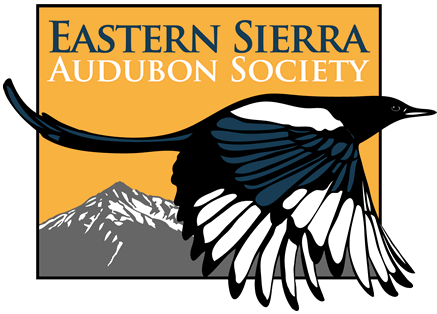by Tom and Jo Heindel
There are four species of longspurs in the world and all four have been reliably documented by specimens or photographs as having occurred in Inyo County. What is a longspur? It is a sparrow in the genus Calcarius that has a long hind claw, hence the name longspur. Two of the four species breed in the northern Great Plains and the other two in the arctic. Most of Inyo County’s records are in fall when birds are dispersing from their northern breeding areas to their winter range which for the most part is to the southeast of us.
East of the Sierra the occurrence of longspurs is somewhat unpredictable, and one is always pleased to encounter them. Two of the four species are very rare both in Inyo County and in the entire state.
There is a single record of Smith’s Longspur for Inyo and just five records for the state. Our visitor was at Furnace Creek Ranch golf course in Death Valley National Park from 4 – 11 October 1997. This bird was very tame and allowed viewers to within ten feet as it foraged on the short grass by the motel.
McCown’s Longspur is also rare with just five records for the county. Other than Smith’s Longspur, which is not recorded annually in California, this species is the next rarest in the state. Two of Inyo County’s records are from Deep Springs Valley, two are from Furnace Creek Ranch and the last one is from near Panamint Springs. All five records are between 16 October and 11 November.
Lapland Longspur occurs annually in the state although it is not recorded annually in Inyo County. It may be here but the large size of the county and the limited number of birders mitigates against encounters. The situation is further complicated by difficulty in identifying birds in fall plumage. Although most often found singly, on 13 October 1949 Don McLean collected a female from a group of forty at Deep Springs (Condor 71:434). There are two spring records both from Furnace Creek Ranch and many fall records between 13 October and 30 November. There is one winter record 17 January 1976 from Furnace Creek Ranch (Larry Mangan, pers. comm.).
The Chestnut-collared Longspur is our most abundant longspur. It occurs annually with most records in fall between late September and late November. There are several very early records starting 5 August 1989 at Furnace Creek Ranch by Michael Patten (American Birds 44:165). Records extend into winter with the latest on 6 February. There are two spring records from Saline Valley and Furnace Creek Ranch. Again they are usually encountered singly, but on 20 November 1993 Andrew & Leah Kirk and Bob Hudson had about seventy in an alfalfa field near Independence.
To find longspurs one should be armed with information from a good field guide (we recommend National Geographic Society’s Birds of North America) and search grasslands in fall. Listen for their distinctive calls and watch for their different tail patterns as they bound away. Good luck!
Tags: longspur, sparrow
